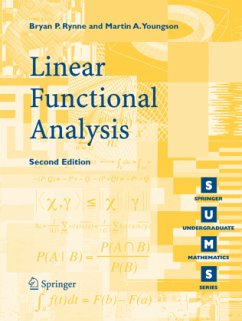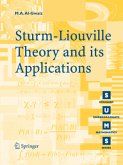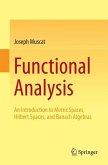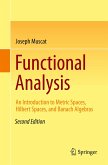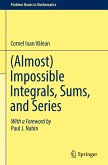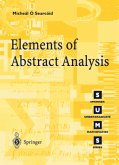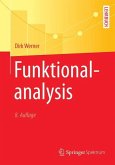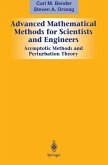This introduction to the ideas and methods of linear functional analysis shows how familiar and useful concepts from finite-dimensional linear algebra can be extended or generalized to infinite-dimensional spaces. Aimed at advanced undergraduates in mathematics and physics, the book assumes a standard background of linear algebra, real analysis (including the theory of metric spaces), and Lebesgue integration, although an introductory chapter summarizes the requisite material. A highlight of the second edition is a new chapter on the Hahn-Banach theorem and its applications to the theory of duality.
This book provides an introduction to the ideas and methods of linear fu- tional analysis at a level appropriate to the ?nal year of an undergraduate course at a British university. The prerequisites for reading it are a standard undergraduate knowledge of linear algebra and real analysis (including the t- ory of metric spaces). Part of the development of functional analysis can be traced to attempts to ?nd a suitable framework in which to discuss di?erential and integral equations. Often, the appropriate setting turned out to be a vector space of real or complex-valued functions de?ned on some set. In general, such a v- tor space is in?nite-dimensional. This leads to di?culties in that, although many of the elementary properties of ?nite-dimensional vector spaces hold in in?nite-dimensional vector spaces, many others do not. For example, in general in?nite-dimensionalvectorspacesthereisnoframeworkinwhichtomakesense of analytic concepts such as convergence and continuity. Nevertheless, on the spaces of most interest to us there is often a norm (which extends the idea of the length of a vector to a somewhat more abstract setting). Since a norm on a vector space gives rise to a metric on the space, it is now possible to do analysis in the space. As real or complex-valued functions are often called functionals, the term functional analysis came to be used for this topic. We now brie?y outline the contents of the book.
Hinweis: Dieser Artikel kann nur an eine deutsche Lieferadresse ausgeliefert werden.
This book provides an introduction to the ideas and methods of linear fu- tional analysis at a level appropriate to the ?nal year of an undergraduate course at a British university. The prerequisites for reading it are a standard undergraduate knowledge of linear algebra and real analysis (including the t- ory of metric spaces). Part of the development of functional analysis can be traced to attempts to ?nd a suitable framework in which to discuss di?erential and integral equations. Often, the appropriate setting turned out to be a vector space of real or complex-valued functions de?ned on some set. In general, such a v- tor space is in?nite-dimensional. This leads to di?culties in that, although many of the elementary properties of ?nite-dimensional vector spaces hold in in?nite-dimensional vector spaces, many others do not. For example, in general in?nite-dimensionalvectorspacesthereisnoframeworkinwhichtomakesense of analytic concepts such as convergence and continuity. Nevertheless, on the spaces of most interest to us there is often a norm (which extends the idea of the length of a vector to a somewhat more abstract setting). Since a norm on a vector space gives rise to a metric on the space, it is now possible to do analysis in the space. As real or complex-valued functions are often called functionals, the term functional analysis came to be used for this topic. We now brie?y outline the contents of the book.
Hinweis: Dieser Artikel kann nur an eine deutsche Lieferadresse ausgeliefert werden.
"The authors write with a strong narrative thrust and a sensitive appreciation of the needs of the average student so that, by the final chapter, there is a real feeling of having "gotten somewhere worth getting" by a sensibly paced, clearly signposted route." Mathematical Gazette, 2000
"It is a fine book, with material well-organized and well-presented. A particularly useful feature is the material on compact operators and applications to differential equations." CHOICE magazine
"The presentation is quite elementary, and there are sufficiently many illuminating examples and exercises... this nice textbook perfectly fits the readership, i.e., undergraduate students in mathematics and physics... It may be recommended to all students who want to get in touch with the basic ideas of functional analysis and operator theory for the first time." Zentralblatt MATH
"It is a fine book, with material well-organized and well-presented. A particularly useful feature is the material on compact operators and applications to differential equations." CHOICE magazine
"The presentation is quite elementary, and there are sufficiently many illuminating examples and exercises... this nice textbook perfectly fits the readership, i.e., undergraduate students in mathematics and physics... It may be recommended to all students who want to get in touch with the basic ideas of functional analysis and operator theory for the first time." Zentralblatt MATH
From the reviews of the second edition:
"The authors write with a strong narrative thrust and a sensitive appreciation of the needs of the average student so that, by the final chapter, there is a real feeling of having "gotten somewhere worth getting" by a sensibly paced, clearly signposted route." Mathematical Gazette, 2000
"It is a fine book, with material well-organized and well-presented. A particularly useful feature is the material on compact operators and applications to differential equations." CHOICE magazine
"The presentation is quite elementary, and there are sufficiently many illuminating examples and exercises... this nice textbook perfectly fits the readership, i.e., undergraduate students in mathematics and physics... It may be recommended to all students who want to get in touch with the basic ideas of functional analysis and operator theory for the first time." Zentralblatt MATH
"I highly recommend this book for independent study or as a supplement to a text. You can see if you're on the right track with exercises because the text has solutions and hints in the back. ... This undergrad text is extremely clear, with lots of examples and exercises." (Philosophy, Religion and Science Book Reviews, bookinspections.wordpress.com, October, 2013)
"This is the second edition of a gentle introduction to basic normed, linear functional analysis. ... it provides a first course on the topic on an (early) undergraduate level. ... The text is carefully written and the clear and precise style makes it an easy read. The book contains many instructive examples and a wealth of exercises including solutions." (R. Steinbauer, Monatshefte für Mathematik, Vol. 162 (3), March, 2011)
"This book is an excellent introductory textbook for upper-level undergraduate (pure) mathematics students and is very well written with much care given to clear, precise, and complete notation andargumentation. ... Plenty of cross-references are included to point the reader to relevant material covered earlier in the book." (Greg E. Fasshauer, SIAM Review, Vol. 52 (1), 2010)
"This is an undergraduate introduction to functional analysis, with minimal prerequisites, namely linear algebra and some real analysis. ... It is extensively cross-referenced, has a good index, a separate index of symbols (Very Good Feature), and complete solutions to all the exercises. It has numerous examples, and is especially good in giving both examples of objects that have a given property and objects that do not have the property." (Allen Stenger, MathDL, April, 2008)
"This second revised edition of the book ... covers the normed aspects in functional analysis and consists of the preface, eight chapters, solutions to exercises (at the end of the book), a bibliography containing 17 references, notation index and subject index. ... The book is readable and conceptually useful for undergraduate students in mathematics and physics. The authors show well how essential concepts from finite-dimensional linear algebra can be extended to the infinite-dimensional case." (Mohammad Sal Moslehian, Zentralblatt MATH, Vol. 1144, 2008)
"The authors write with a strong narrative thrust and a sensitive appreciation of the needs of the average student so that, by the final chapter, there is a real feeling of having "gotten somewhere worth getting" by a sensibly paced, clearly signposted route." Mathematical Gazette, 2000
"It is a fine book, with material well-organized and well-presented. A particularly useful feature is the material on compact operators and applications to differential equations." CHOICE magazine
"The presentation is quite elementary, and there are sufficiently many illuminating examples and exercises... this nice textbook perfectly fits the readership, i.e., undergraduate students in mathematics and physics... It may be recommended to all students who want to get in touch with the basic ideas of functional analysis and operator theory for the first time." Zentralblatt MATH
"I highly recommend this book for independent study or as a supplement to a text. You can see if you're on the right track with exercises because the text has solutions and hints in the back. ... This undergrad text is extremely clear, with lots of examples and exercises." (Philosophy, Religion and Science Book Reviews, bookinspections.wordpress.com, October, 2013)
"This is the second edition of a gentle introduction to basic normed, linear functional analysis. ... it provides a first course on the topic on an (early) undergraduate level. ... The text is carefully written and the clear and precise style makes it an easy read. The book contains many instructive examples and a wealth of exercises including solutions." (R. Steinbauer, Monatshefte für Mathematik, Vol. 162 (3), March, 2011)
"This book is an excellent introductory textbook for upper-level undergraduate (pure) mathematics students and is very well written with much care given to clear, precise, and complete notation andargumentation. ... Plenty of cross-references are included to point the reader to relevant material covered earlier in the book." (Greg E. Fasshauer, SIAM Review, Vol. 52 (1), 2010)
"This is an undergraduate introduction to functional analysis, with minimal prerequisites, namely linear algebra and some real analysis. ... It is extensively cross-referenced, has a good index, a separate index of symbols (Very Good Feature), and complete solutions to all the exercises. It has numerous examples, and is especially good in giving both examples of objects that have a given property and objects that do not have the property." (Allen Stenger, MathDL, April, 2008)
"This second revised edition of the book ... covers the normed aspects in functional analysis and consists of the preface, eight chapters, solutions to exercises (at the end of the book), a bibliography containing 17 references, notation index and subject index. ... The book is readable and conceptually useful for undergraduate students in mathematics and physics. The authors show well how essential concepts from finite-dimensional linear algebra can be extended to the infinite-dimensional case." (Mohammad Sal Moslehian, Zentralblatt MATH, Vol. 1144, 2008)

